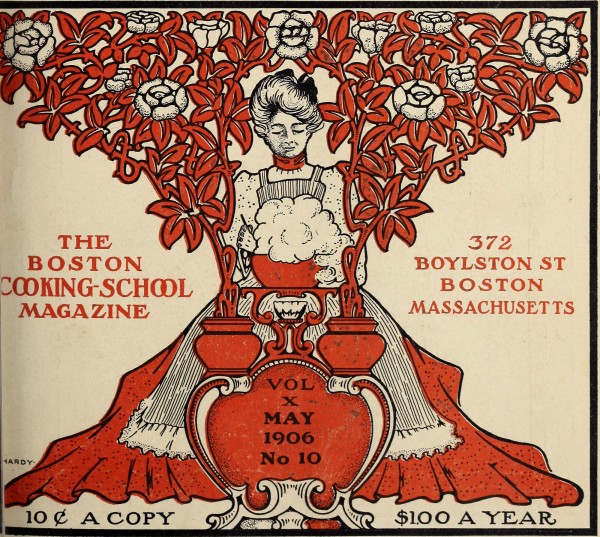1906
As I continue to examine Fannie Farmer’s earnest observations and advice on tea in her Boston Cooking School Cookbook, it might be useful to put her book into the context of the world in which she and her readers live.
- Wilfred Laurier is Prime Minister of Canada
- Theodore Roosevelt is president of the USA
- As mentioned in Part 1 of this post, The US establishes the Food and Drug Act to ensure that only food that passes inspection may be shipped interstate.
- The Battle Creek Toasted Corn Flake Company is formed (Kellogg)
- Qing Imperial anti-opium edict signed in China
- The Plaza Hotel opens in New York City
- Glasgow Style, Arts and Crafts and Art Nouveau are present in design and architecture
- Meiji period exports from Japan are popular in the west (Europe and N. America)
- Women’s Suffrage movement is gaining momentum

Page 33 top – “brands”, proteid and nutriments!
This section of Fannie Farmer’s notes on tea is loaded with information, both amusing and perplexing. There’s a lot of rich material here. In this installment, I’ll examine the top half of the page. Follow along with the highlighted entries and the bits around them:

First she identifies for the reader, the most popular types of tea at the time.
- “familiar brands” – Tea blends and types must have become so much a part of the everyday that they were referred to as brands. (like “hoovering the carpet”)
- “Formosa” – The west still referred to Taiwan as Formosa at this time. It wasn’t until after WWII that English speaking nations referred to the island as Taiwan.
- “Orange Pekoe” – Fannie was right that Flowery Pekoe was made from the youngest leaves, but got it wrong when she asserted that Orange Pekoe was scented with orange leaves. Like many to this day, she had the misguided belief that the word “Orange” represented tea flavour, when it actually represented a standard or grade referencing the Dutch Royal House of Orange.
- Most green tea consumed in America was sourced in Japan, but it wasn’t necessarily the best green tea. This 1906 edition of her cookbook predates the Communist revolution in China where fairly good green tea was still being produced, but because Japan was more amenable to trade with the west, most green tea bound for the U.S. was sourced there.
- What is Proteid? – Proteid is an archaic term that refers to organic matter containing proteins and amino acids. Some definitions:
i. A complex biomolecule predominantly made of polypeptides. Found in all living matter.
ii. Any organic material rich in proteid molecules considered a dietary source of essential amino acids.
- Nutriment – Farmer claims that tea holds little nutrition as an infusion, but becomes more nutritious with the addition of milk and sugar. Sugar is now held in low regard by many health professionals. The modern approach to tea is to take it clear without any additions, unless it is a black tea blend or Masala Chai. While we don’t usually refer to them as nutrients, we know that tea (particularly green tea) contains components that contribute to overall wellness. Polyphenols, flavinoids, Amino acids and Vitamin C are all present in tea.
- Theine def.- another name for caffeine, esp when present in tea
- Tannic Acid -Tea does not contain tannic acid, the chemical used to soften leather. Tea does contain tannins. They become thearubigens as a result of oxidation. There is a good article on the website, Rate Tea about tannins. Farmer claims that tea injures the stomach lining. This would not be caused by tannins. It is possible that too much caffeine could cause nausea and stomach upset.
Farmer’s approach throughout the book is to awaken our interest in what we eat, to better the human race through scientific cookery. “It is my wish…that (the cookbook) may awaken an interest through its condensed scientific knowledge which will lead to deeper thought and broader study of what to eat.” – FMF
While the language and recipes are quaint, her knowledge of tea, given the time, was quite good. Hers was a solitary voice in the world of cookery, with a desire to define and explain what we eat and drink.
Part 3 (conclusion) coming soon.




